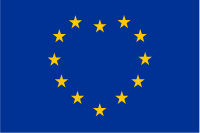 Heart of Europa Heart of Europa |
 Heart of Europa Heart of Europa |
The Heart of Europa is a large region in central Europe. It is situated roughly between 45°-50° north latitude and 10°-26° east longitude and is currently divided among several EU members and their neighbouring countries.
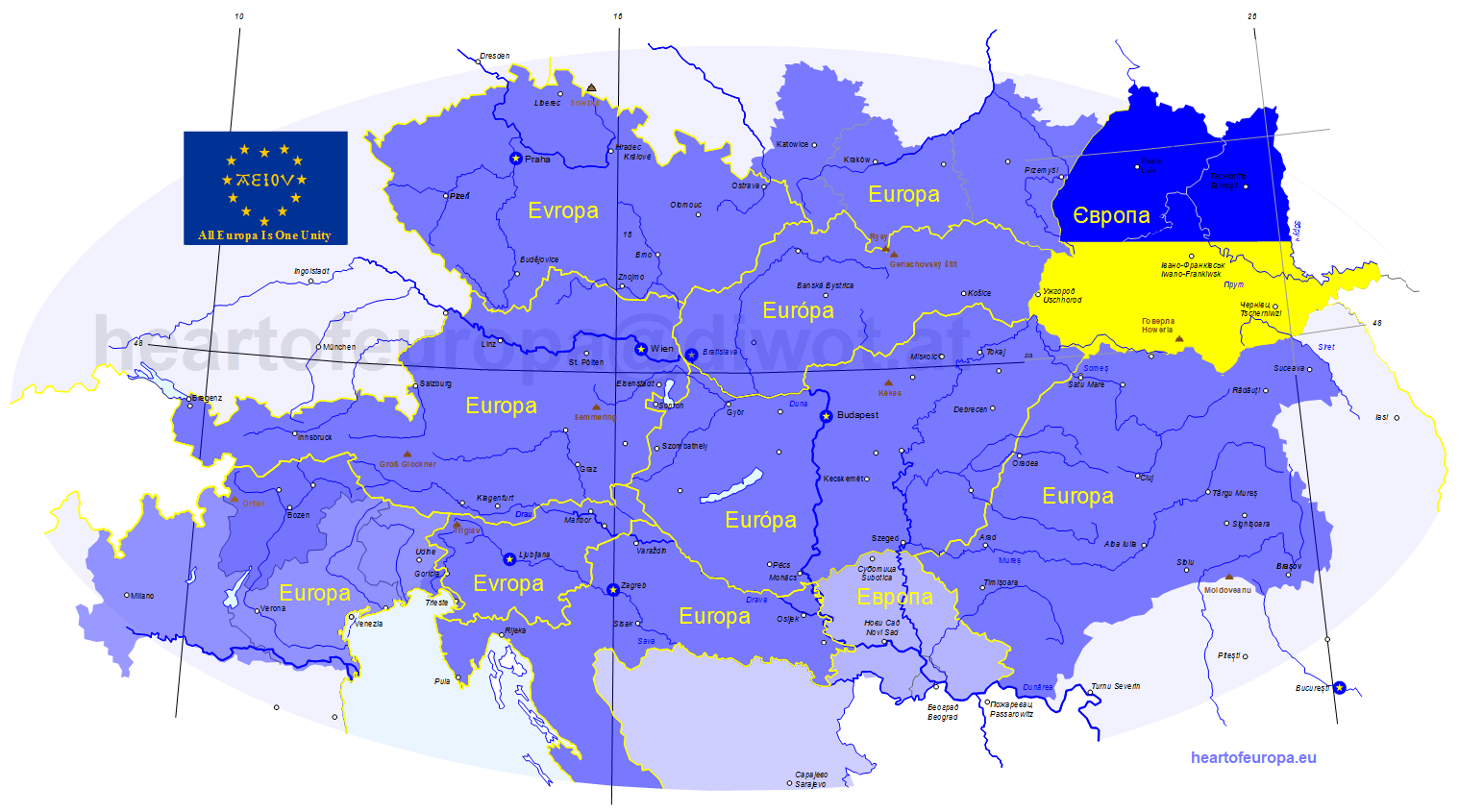

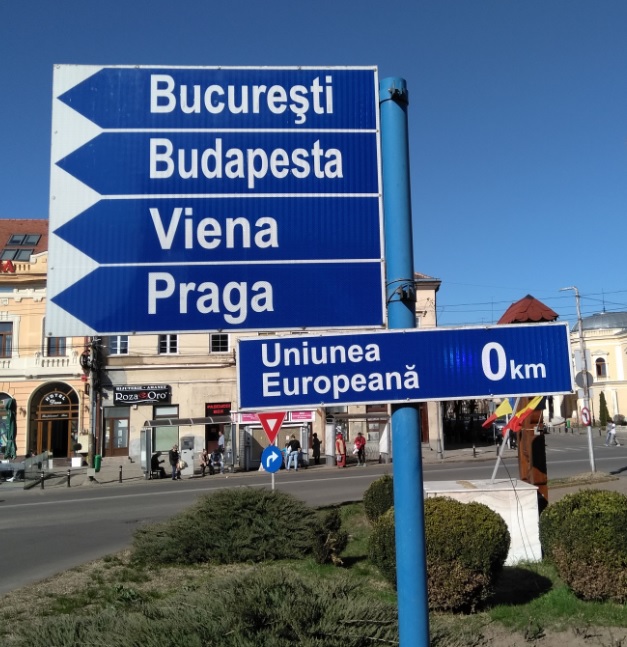
Signpost in Satu Mare
Calpadunnia
It stretches from the CArPAthian mountain range to the Eastern ALPs, embracing the PANNonian Basin with the entire Danube (DUNa, Dunaj, Dunav, Dunărea) river system, reaching the northern AdrIAtic in the west. The region is extremely rich in culture and natural beauty, with dozens of languages spoken and a most diverse history reaching back to the Roman Empire.
Enjoy your tour through the Heart of Europa! If you would like to see some information about your region or town you are kindly invited to send your ideas to info@heartofeuropa.eu.
Did you know?
Baltoscandia
In 1928 Swedish geography professor Sten de Geer suggested closer ties betweeen the seven countries surrounding the Baltic Sea in order to strengthen political, economic and political cooperation:
three Baltic states (Lithuania, Latvia, and Estonia),three Scandinavian countries (Denmark, Sweden, Norway), plus Finland.
In the period after World War I the idea of a Baltoscandian Confederation was in the interest of those small countries to gain strength against powerful neighbors.
However, such a confederation never became a reality. Today, 27 European countries are united in the European Union which might develop into a European Confederation or even United States of Europa one day .
Misija Lietuva 100 - what is Baltoscandia?
20th anniversary of EU enlargement
On 1 May 2004 the largest enlargement of the European Union took place. In total, ten countries joined the EU, five of these belong to the Heart of Europa: Czechia, Slovakia, Poland, Hungary, Slovenia. Romania followed in 2007, Croatia in 2013. Now Heart of Europa is still waiting for the accession of Bosnia and Herzegovina, Serbia and EUkraine in coming years. Membership in the EU brings many benefits: free movement of people (citizens), goods, services and capital.
Three Seas Initiative
The Three Seas Initiative is a platform that aims to promote cooperation, first and foremost, for the development of infrastructure in the energy, transport, and digital sectors. It targets new investments, economic growth, and energy security and brings together 13 countries located between the Baltic, Black, and Adriatic/Aegean seas – Estonia, Latvia, Lithuania, Poland, Czechia, Slovakia, Austria, Hungary, Slovenia, Croatia, Romania, Bulgaria and Greece.
The last summit took place 11 April 2024 in Vilnius, Lithuania.
Weltausstellung 1873 Universal Exhibition Vienna
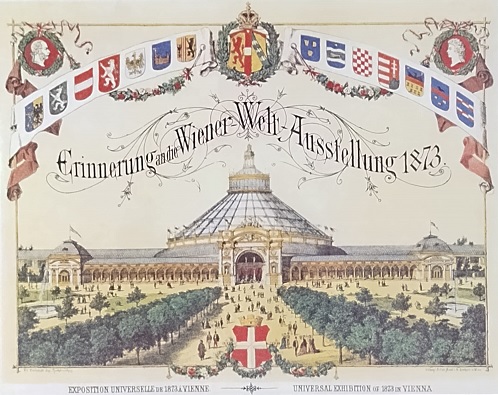
Erinnerung an die Weltausstellung 1873
The Universal Exhibition of 1873 in Vienna was a major event of many records and impressive showpieces. The Rotunde erected as the centrepiece of the exhibition was the largest dome construction in the world for many decades. The exhibition marked the beginning of a dynamic development process in the economic, technical and cultural fields in the Heart of Europa.
Wiener Weltausstellung 1873 revisited (german)
Österreichisches Biografisches Lexikon / Österreichische Akademie der Wissenschaften
Photo collection available at Technisches Museum Wien (german)
Central European Defence Cooperation
Central European Defence Cooperation (CEDC) was established in 2010. It brings together Ministries of Defence from six member states (Austria, Croatia, Czech Republic, Hungary, Slovakia and Slovenia) and one observer state (Poland).
Today, CEDC represents a security and defence platform for the participants in order to discuss, develop and promote common interests. The principle goal of the CEDC is to contribute to the strengthening of regional security within the framework of EU and NATO PfP by promoting specific regional interests of the Participants. In particular, the cooperation focuses on coordinating EU policies, tackling common regional challenges and threats, initiating projects among armed forces and capacity-building. Being aware that regional security is intrinsically connected with the security of neighbouring regions, a cooperation with Western Balkan partners has also been established.
AEIOU
AEIOU (A.E.I.O.U.) is a historical motto of Frederick III (Holy Roman Emperor, 15th century)
Frederick started using his motto when he was Duke of Styria. It is not known what exactly was meant by it, most of the countless interpretations in Latin or German refer to "Austria". The five-letter abbreviation is still found today on various buildings (for example the Castle of Wiener Neustadt in the south of Vienna which houses the Military Academy)
Heart of Europa proposes a present-day interpretation:
All Europa Is One Unity
Josefstadt - Iosefin - Jószefváros
Josefstadt is a district in the city of Vienna, Austria (8. Bezirk). There is also a district Iosefin in the west-romanian town Timişoara, Romania and a district Jószefváros in Budapest, Hungary (VIII kerület). The names date back to emperor Joseph II. The three districts maintain a partnership.
In March 2019 Asociaţia Culturală Salvaţi Patrimoniul Timişoarei (Association for the Salvage of Cultural Heritage Temesvar) organised the photo exposition Iosefin - Die Josefstadt von Temesvar in cooperation with Österreichisch-Rumänische Gesellschaft (Austrian Romanian Society).
Pannonia & Dacia
Pannonia and Dacia were provinces in the Roman Empire which existed from the 1st to 5th century and 2nd to 3rd century, respectively. Pannonia covered the western part of modern Hungary (west of river Danube), Dacia corresponds to the region of Transylvania, Romania, reaching southwards to the river Danube. The names of both provinces survived until today and are popular in tourism and they are also frequently used in other domains such as geography or transportation. There are the 'Pannonian basin' and 'Pannonian climate'. In general the name ist frequently used in tourism both in Hungary and in the Austrian province "Burgenland". Dacia is the name of an auto brand, the night train D347 from Vienna to Bucharest is called "Dacia Express" and in Romania it is a popular oppinion that the Romanian nation has its ancient roots in Dacia. The landmark Hotel Dacia in the town of Satu Mare, northwest Romania, was previously named Pannónia when the region belonged to Hungary.
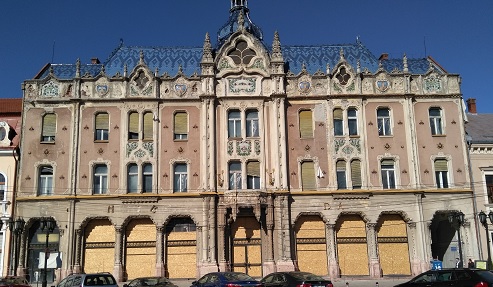
Hotel Dacia, Satu Mare in 3/2019, desperately waiting for renovation
In the News
Capital of Culture - Nova Gorica / Gorizia
February 8, 2025 The twin cities Nova Gorica (Slovenia) and Gorizia (Italy) celebrated the opening of their common year as Capital of Borderless Culture 2025. The all-day opening festivities were completed by the official inauguration at Europe Square, the symbolic heart of both cities.
The town of Görz was located in the heart of the historic region Österreichisches Küstenland / Austrian Litoral / Litorale Austriaco / Avvstrijiska Primorska. After World War I parts of the region became part of Italy, after Word War II the town was divided into two halves.
Ukraine: Chop-Uzhhorod European gauge railway
On April 4, 2024 Prime Minister of Ukraine Denys Shmyhal launched a project to build the Chop-Uzhhorod European gauge railway. This will make it possible to establish a direct railway connection between Uzhhorod and Vienna, Bratislava, Kosice, Budapest, Prague, Bucharest, Dresden, and Belgrade.
The project will create a transport hub in Uzhhorod that will provide convenient and fast passenger transfers between wide-gauge trains and trains of EU countries.
It will bring Ukraine’s railway closer to European standards and increase operational efficiency.
Financing will be supported by EU grants under the Connecting Europe Facility programme (CEF).
It is expected that the project will be
finished by the end of the second or early third quarter of 2025.
A similar project between Chernivtsi (UA) and Suceava (RO) will start in early 2025.
Train Connection Ukraine - Romania reopened
On January 17, 2023 Ukrainian Railways Укрзалізниця, Ukrzaliznytsia reopened a cross-border conncection between the Transcarpathian city of Rakhiv (Рахів) and the small Romanian border-town of Valea Vișeului in Maramureș County, northwestern Romania.
Short as the connection may seem, 22 km, it is an important symbol for linking Ukraine closer to the Heart of Europa.
Furthermore, this track is part of 19th century historic railway route between the northeast of Hungary and the Austrian Empire crown land Galicia. The original track was opened in 1894/95 and featured some impressive bridges, tunnels and viaducts. At that time, the famous Bridge of Jaremcze (міст Яремче) was the world's longest single-arch stone bridge with a span of 65m and viaducts at both sides. Unfortunately, it was destroyed in the 20th century. (see chapter Transport, lost places)
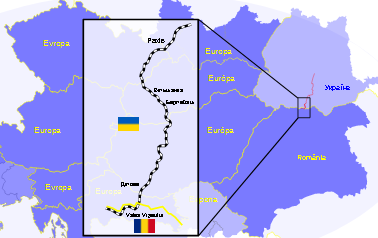
Railway Rakhiv - Valea Viseului
Capital of Culture: Timisoara 2023
Between 17 - 19. February 2023 the Capital of Culture Timisoara launched its opening programme with more than 130 events in three days.
Timisoara / Temesvár / Temeschwar is Romania's third-largest city in the western part of the country close to the hungarian and serbian border. It is an important industrial, commercial and cultural centre in the region and has strong historic and cultural ties to Central Europa. The building of the National Theatre and National Opera is also home to the Hungarian State Theatre and the German State Theatre being an impressive symbol of the multicultural tradition in Timisoara.
Mura-Drava-Danube 5-countries biosphere reserve
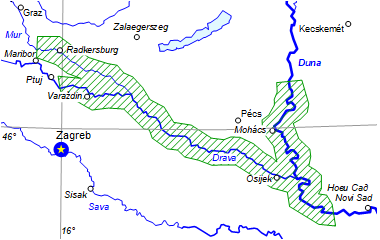
Mura-Drava-Danube 5-countries biosphere reserve
In September 2021 UNESCO declared the Mura-Drava-Danube river system as 5-countries biosphere reserve. The respective region is entirely situated in the Heart of Europa, it stretches from Austria via Slovenia, Croatia and Hungary to Serbia. 13 protected areas of various size and composition (national parks, reservations, Natura 2000 sites) form the biosphere network with a length of 700km and a total size of 930.000 hectares.
Danubian Limes becomes UNESCO World Heritage site
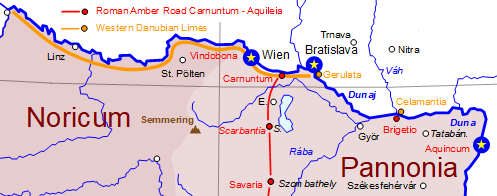
Danubian Limes in Austria and Slovakia
On July 30, 2021, the UNESCO World Heritage Committee decided to add the western part of the Danubian Limes to the list of World Heritage Sites. "Limes" is the modern term for the military frontier of the Roman Empire. The Danubian Limes, or "wet" limes, stretched from Bavaria to the Black Sea. The site was nominated by Austria, Germany and Slovakia. Originally, Hungary was also a partner in the nomination process but decided later to withdraw from the partnership. The Danubian Limes is a part of the UNESCO World Heritage project "Frontiers of the Roman Empire".
derstandard.at - Donaulimes mit Österreich-Abschnitt zum Weltkulturerbe erklärt
spectator.sme.sk - Another UNESCO world heritage site in Slovakia dates back to the Roman Empire
hang.hu - A magyar szakasz nélkül is világörökségi védettséget kap a dunai limes
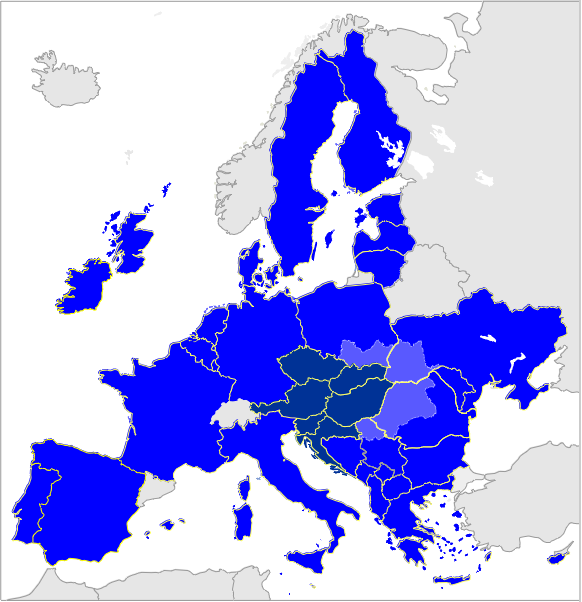

 | EU Strategy for the Danube Region (EUSDR) | 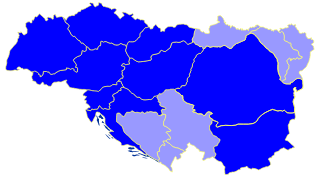 |
Via Carpatia | 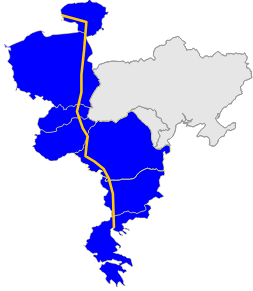 | |
 | Three Seas Initiative | 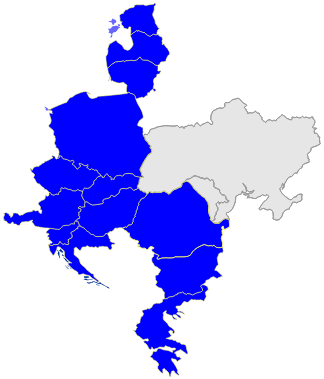 |
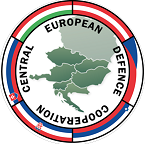 | Central European Defence Cooperation | 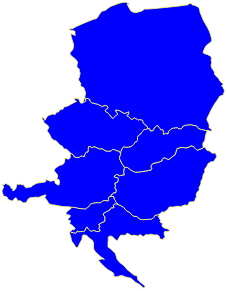 |
 | Central European Initiative | |
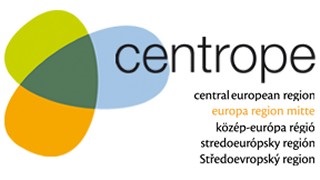 | Centrope | 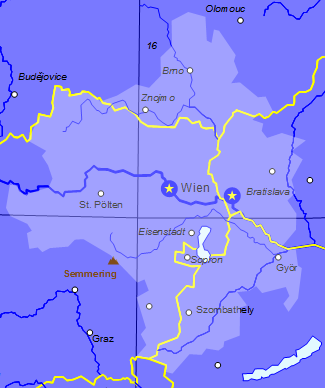 |
 | Institut für den Donauraum und Mitteleuropa | |
 | Interreg Central Europe | |
 | Danube Transnational | |
 | Interreg Czechia - Austria - interreg.eu - www.at-cz.eu Czechia - Slovakia - interreg.eu - www.sk-cz.eu Czechia - Poland - interreg.eu - www.cz-pl.eu Slovakia - Austria - interreg.eu - www.sk-at.eu Slovakia - Poland - interreg.eu - pl.plsk.eu Slovakia - Hungary - interreg.eu - www.skhu.eu Romania - Hungary - interreg.eu - interreg-rohu.eu Romania - Serbia - interreg.eu - www.romania-serbia.net Serbia - Hungary - interreg.eu - www.interreg-ipa-husrb.com Croatia - Serbia - interreg.eu - www.interreg-croatia-serbia2014-2020.eu Croatia - Hungary - interreg.eu - www.huhr-cbc.com Croatia - Slovenia - interreg.eu - www.si-hr.eu Croatia - Italy - interreg.eu - www.italy-croatia.eu Slovenia - Hungary - interreg.eu - www.si-hu.eu Slovenia - Austria - interreg.eu - www.si-at.eu Slovenia - Italy - interreg.eu - www.ita-slo.eu Italy - Austria - interreg.eu - www.interreg.net |
All trademarks, trade names, product names and logos appearing on the site are the property of their respective owners.
The Three Seas logo is registered with the European Union Intellectual Property Office.
The Trans-European Transport Network (TEN-T) is a European Commission policy directed towards the implementation and development of a Europe-wide network of roads, railway lines, inland waterways, maritime shipping routes, ports, airports and rail-road terminals. It consists of two planning layers:
The Comprehensive Network: Covering all European regions
The Core Network: Most important connections within the Comprehensive Network linking the most important nodes
 | 4 Core Network Corridors pass through the Heart of Europa: |
Corridor Rhine Danube - Mediterranean Vienna/Bratislava - Budapest - Níregyháza - Ukrainian border/Romanian border Satu Mare

road layout based on © OpenStreetMap contributors 2/2019
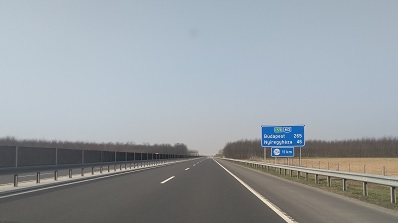
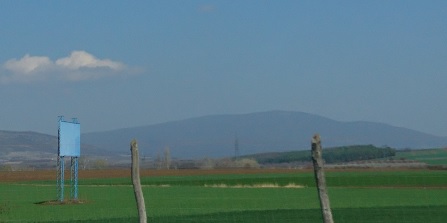
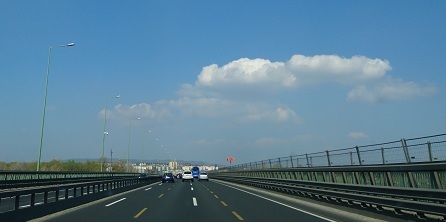
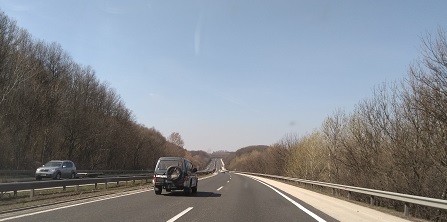
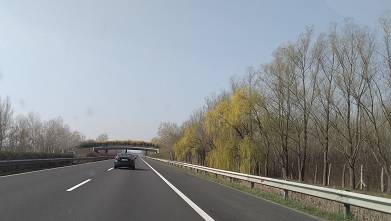
Corridor Rhine Danube Vienna/Bratislava - Budapest - Szeged - Timisoara - Sibiu - Bucharest
One section of motorway A1 in Romania between Ilia and Deva was opened to traffic in August 2019, the second section between Holdea and Ilia was opened on December 23, 2019 (speed and weight limitation).
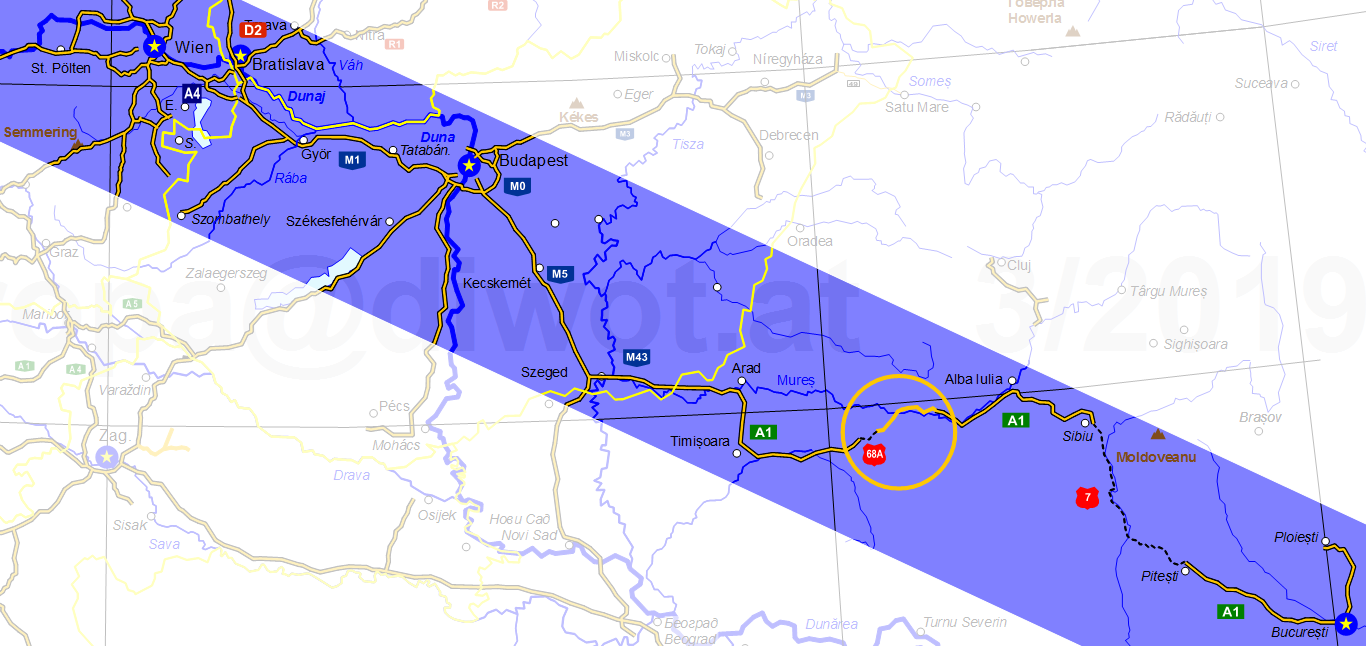
road layout based on © OpenStreetMap contributors 2/2019
The diagram presents a selection of direct end-to-end connections between major cities in the Heart of Europa (1/2019)
In October 2019 Austrian Federal Railways ÖBB announced new direct connections between Vienna and Satu Mare, RO, and Przemysl, PL, starting with winter timetable 2019.
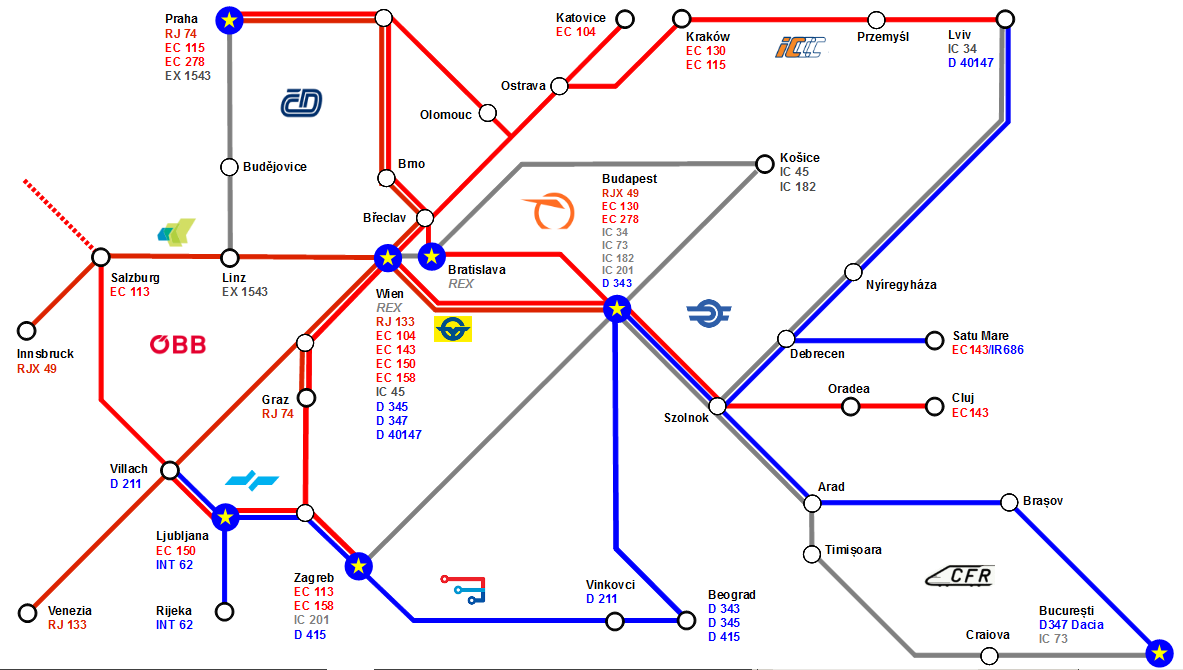
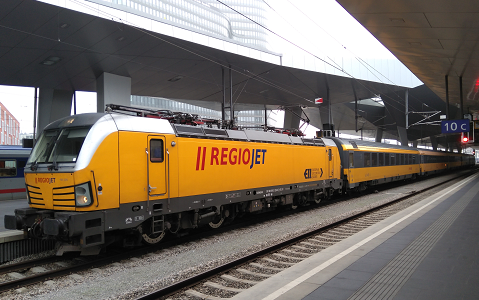
RegioJet Vienna - Prague
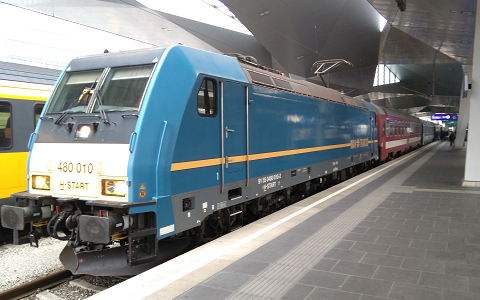
EC 143 Transilvania, Vienna - Cluj
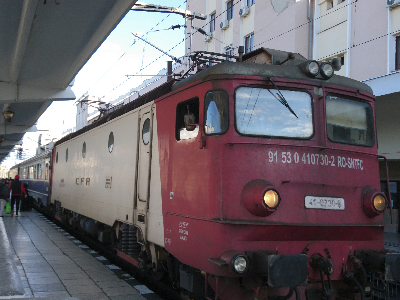
IR 72 Traianus, Timisoara - Budapest
All trademarks, trade names, product names and logos appearing on the site are the property of their respective owners.
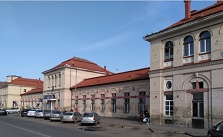
Station Satu Mare, built in 1899
History of railway network - Overview |
|
Timeline |
|
Südbahn Gesellschaft |
|
North - East |
|
Ungarische Nordostbahn |
|
Marchthalbahn |
History Marchthalbahn (PDF, german) |
South - Central |
|
Romania |
Lost Places
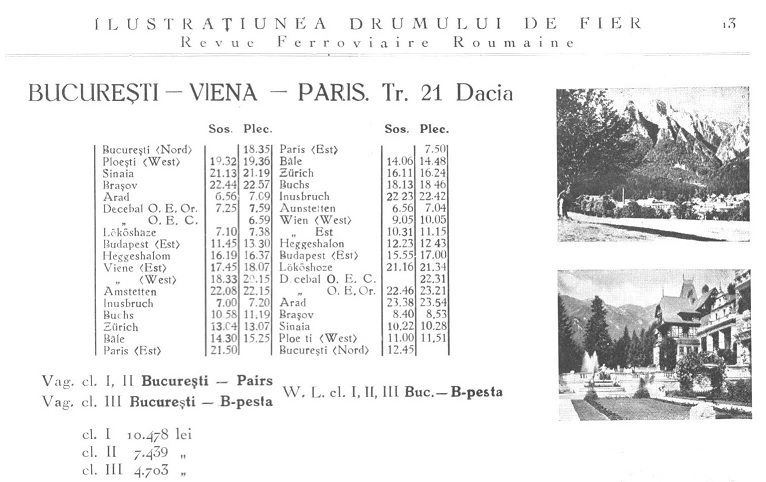
Timetable train Bucharest - Vienna "Dacia" from Ilustratiunea Drumului de Fier, September 1933
![]()
Theatrescu encourages the information exchange between and offers visibility to artists from the Romanian, Moldavian and Italian theatre scenes. Theatrescu serves as polyglot networker and offers organizational support for cross-border, multi-language theatre projects.
Theatrescu projects in: Milano, Udine, Ingolstadt, Wien, Graz, Timisoara, Cluj, Bucuresti, Iasi
Aurel Popovici (1863 - 1917) was a Romanian intellectual and politician. In 1906 he published the concept of "United States" in the Heart of Europa, a federation of autonomous states based on national and ethnic principles, 101 years before the EU Treaty of Lisbon was signed in 2007.
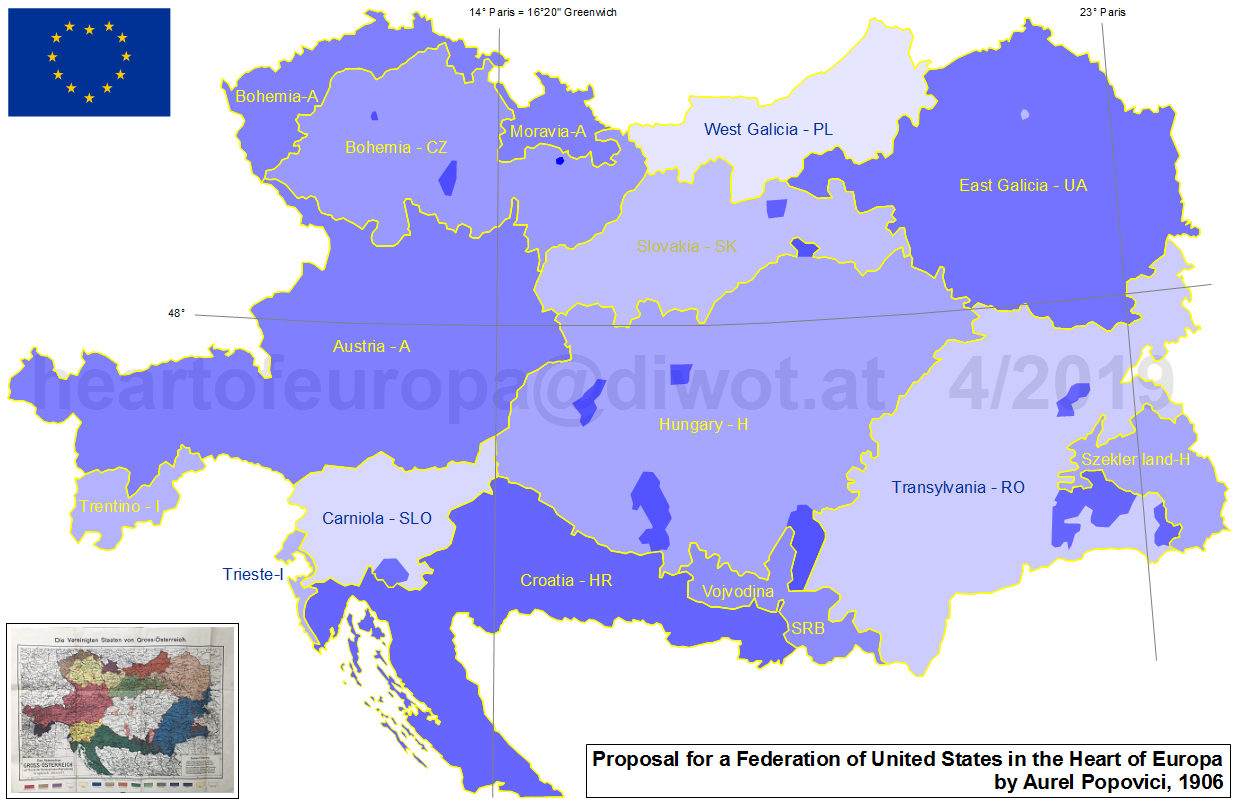

Weblinks
"United States", Proposal by Aurel Popovici, Verlag B. Elischer Nachfolger, Leipzig, 1906, Austria Forum Web-Book
Popovici, Aurel C., 1863-1917 [Verfasser], Leipzig : Elischer Nachf. ; 1906, Österreichische Nationalbibliothek / Austrian National Library, onb.ac.at
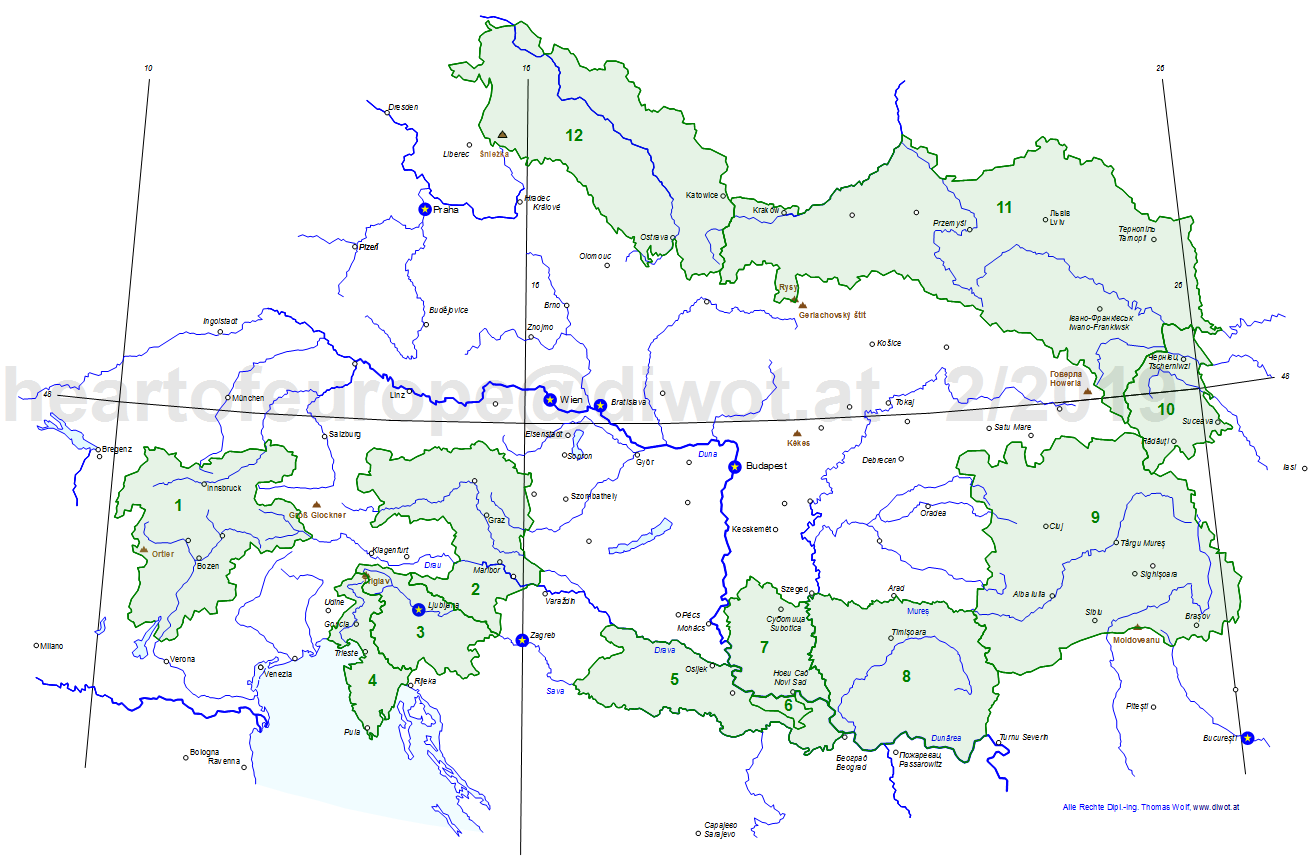

| 1 | A, I | Tyrol | Tirol | |
| 2 | A, SLO | Lower Styria | Untersteiermark | |
| 3 | SLO | Carniola | Krain | |
| 4 | I, SLO, HR | Austrian Littoral | Küstenland | |
| 5 | HR, SRB | Slavonia | Slawonien | |
| 6 | HR, SRB | Syrmia | Syrmien | |
| 7 | H, SRB | Bačka | Batschka | |
| 8 | H, RO, SRB | Banat | Banat | |
| 9 | RO | Transylvania | Siebenbürgen | |
| 10 | RO, UA | Bukovina | Bukowina | |
| 11 | PL, UA | Galicia | Galizien | Galicia is a historical and geographical region in central-eastern Europe, today divided between western Ukraine and eastern Poland. ForgottenGalicia.com is a place to collect, document, share and help preserve remnants of the past before they are forgotten or disappear forever. |
| 12 | CZ, D, PL | Silesia | Schlesien |
Eastern and Western Galicia 1809 |
|
Bukovina 1907 |
|
Bukowina |
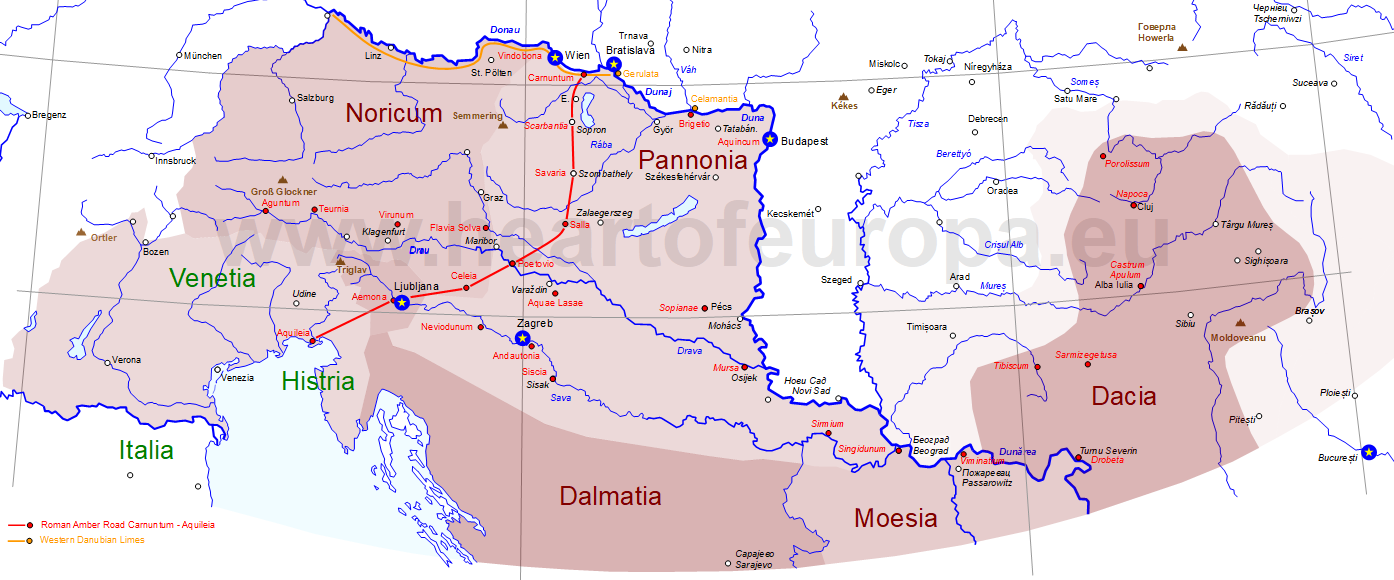

In the period of the Roman Empire 5 provinces existed in the Heart of Europa from 1st-5th century: Pannonia, Noricum, Dacia, Dalmatia, Moesia. Venetia & Histria were regions in Italia. Provinces were reorganized several times, the map shows approximate borders at the beginning of the 2nd century (in the time of Hadrian).